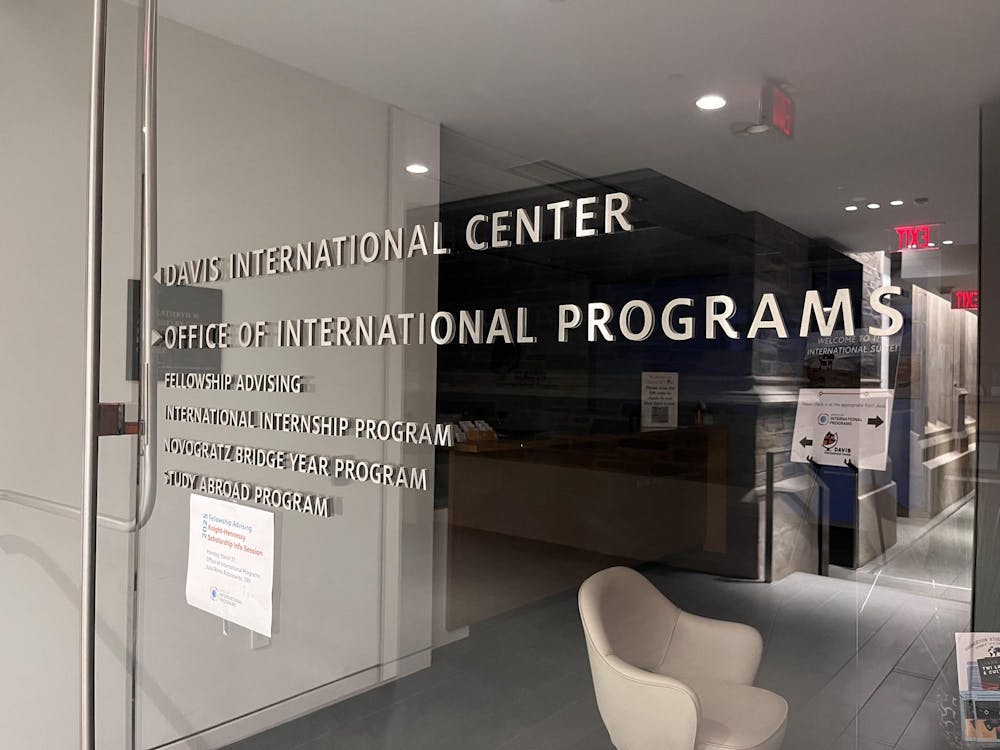Both George Kennan '25 — the diplomat whose containment strategy guided the U.S. through the Cold War — and Yale University diplomatic historian John Lewis Gaddis are known for their tough-minded acuity in navigating the complex relationship between the U.S. and the Soviet Union.
But when Gaddis, who has spent two decades getting to know Kennan in order to write a biography of him, spoke Sunday in McCormick Hall, his tone was more personal than political.
"Every time we have parted company for the last 15 years, there has been a sense that this might be the last time we see each other," a visibly emotional Gaddis said, in a reference to Kennan, who is 99 years old. "This morning, I told him that it has been an honor to devote a chunk of my life to the study of his. We shook hands, and hugged, without knowing whether this was the last time."
The Gaddis lecture, coinciding with the opening of an exhibit on Kennan's life at Firestone Library, marked the first in a series of events celebrating the diplomat's upcoming centennial year.
University officials announced yesterday that U.S. Secretary of State Colin Powell would visit campus in February 2004 to deliver an address in honor of Kennan on his birthday and to accept an award from a student group.
Kennan — perhaps best-known for proposing a global policy of political resistance to Soviet aggressions in the so-called Long Telegram while he was a junior officer in the U.S. embassy in Moscow in 1946 — continues to live on Hodge Road in Princeton with his wife, Annelise.
Referring only incidentally to Kennan's advocacy, Gaddis sketched a surprisingly intimate portrait of Kennan's fears, desires and philosophy of life.
"The greatest tragedy of human existence is that we don't die at the same time as those we love," Kennan once wrote, according to Gaddis.

The quote, which Gaddis plans to use in the first line of the biography, was drawn from Kennan's personal diary, which Gaddis said is "not just any diary – this is going to be a classic of American history."
"It captures the look and feel and smell of events," Gaddis said. "For the past seven years it has recorded his dreams, often in vivid detail."
Hinting more about the yet-to-be completed work, Gaddis said, "You may be surprised by the content. There is relatively little of high politics and diplomacy. It's about life and loving and pain and death. Even sex, occasionally."
The diary begins in 1916, when Kennan was 12, and continues through the present day. In fact, Gaddis said, he was "handed the most recent entry just this morning."

Gaddis portrayed the famed diplomat as a man haunted throughout life by the loss of his mother when he was just two months old. In one incident drawn from the diary, Gaddis said that Kennan dreamt in 1999 that he was searching for his mother in a crowd of Russian peasants.
Gaddis, who frequently compared his relationship with Kennan to biographer James Boswell's relationship with Samuel Johnson in 18th century Britain, at one point recounted his initial approach to Kennan, in 1981.
Kennan at first said he had given no thought to a biography, telling Gaddis, "My life, though rich in ironies, has not been a dramatic one."
But this may have been somewhat disingenuous on Kennan's part, as Gaddis has found among the diplomat's papers from before that time "notes to biographers that you should think about this and this and this," he said.
Gaddis, then a young academic, secured Kennan's promise not to read or suggest changes to the manuscript of the biography.
"I wanted this to be a posthumous biography," Gaddis said, wryly noting that "actuarial tables" led him to believe that Kennan, then 77, would not live much longer.
That prediction was incorrect, of course.
"George regularly apologizes for delaying the biography by living for so long," Gaddis said, to laughter. "I worry sometimes that he might outlive me."
Gaddis also recounted some of Kennan's brushes with fame. The diplomat held a post at the Institute for Advanced Study in Princeton in the early 1950s, at the same time as Albert Einstein. Gaddis said he once asked Kennan about his relationship with the famed mathematician.
"There was none," Kennan replied. "He was busy, I was busy, we nodded at each other and smiled, but never spoke."
Decades later, at a banquet, Kennan found himself sitting next to a woman who was said to have known 'Lenin.'
Kennan was puzzled, Gaddis said, because she looked much too young to have been a contemporary of the man who led the Russian Revolution in 1917.
The woman was Yoko Ono, and the man John Lennon, not Vladimir Illyich of Bolshevik fame.
Gaddis, who has visited the Kennan family farm in Pennsylvania and the Ohio house where Kennan lived as a child, said he strove to maintain a distance from Kennan even as their friendship deepened.
Apparently, the architect of American policy in the postwar world took note of that effort.
"One of the things I like about you is you're only occasionally around here. You're not always under foot," Kennan once told his biographer, Gaddis said.
Gaddis said he was unsure when he would complete the biography, but that it would likely be published within five years of Kennan's death.







